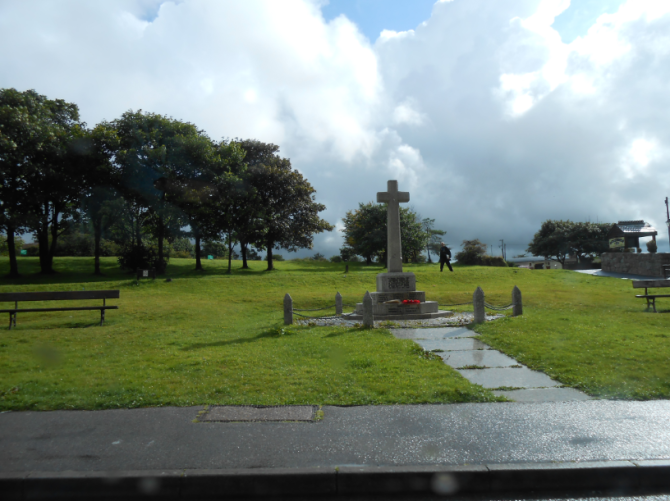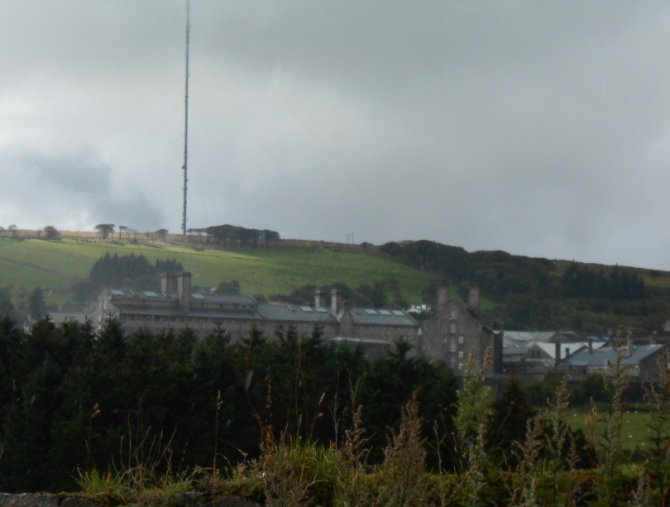Moving on from the charming town of Tavistock, we arrived in the famous Dartmoor National Park, and more specifically, the village of Princetown, one of the most notable areas of the Park…
Princetown:
Status: West Devon District, Devon, Village, England
Date: 14/08/2014
Travel: Car
Eating & Sleeping: N/A
Attractions: Dartmoor National Park, Dartmoor Prison, War Memorial, St Michael’s Church, Dartmoor National Visitor Centre etc
One of Dartmoors most famous landmarks, the imposing figure of Dartmoor Prison, located on the outskirts of the village when you come in from the West. Despite it being one of the most famous prisons in England, it is in fact only a Category C prison, which means the prisoners aren’t safe enough to release but won’t try to escape.
The prison originally opened in 1809, when new space for French POW’s (Prisoners of War) was needed during the Napoleonic Wars between Britain and France. Originally prisoners were kept on special ships but they weren’t very secure and space was fast running out, hence construction of Dartmoor was started in 1806, and completed 3 years later. The 1st prisoners arrived that year and over the course of the war thousands of soldiers were imprisoned here.
Various wars followed and Dartmoor remained an important prison, until 1851 when it became a civilian prison for the next 70 years. In 1917 it was turned into a Home Office Work Centre and prisoners were free to come and go as they wished, until it once more became a full prison in 1920. Today the prison is still open, and whilst its reputation doesn’t come from the prisoners it contains, it’s location gives it the status it now enjoys. Located as it is in the centre of Dartmoor National Park, a vast open space with little to no human activity, it is a long way to the nearest population centre, not counting Princetown, as escaped prisoners wouldn’t have lasted long in such a close proximity to the prison.
The nearest town, Tavistock, is nearly 8 miles to the West, a long walk over open terrain where capture would have been quick. The picture shown is looking directly at the main entrance, which I snapped as we drove past it in the car.
Continuing through the village, we came across the local Parish Church, that of St Michael, built between 1810 and 1814. Unusually for a Parish Church, it wasn’t actually built by the locals, but the original prisoners of the Church, to designs by Daniel Alexander. This gives it the unique status of being the only Church in England to have been built in such a way.
The Church is much larger now than it was originally, due to expansions in both 1898 and 1901. Whilst still in occasional use it is largely decorative now, but it’s stunning granite form adds to the rugged landscape of the National Park, and the village itself.
Further into the village lies the Princetown War Memorial, erected after World War I to commemorate all those from the village who lost their lives in the Great War. It was updated after World War II and remains a permanent reminder of those two horrific wars.
As one of the more major settlements in the National Park, Princetown is also home to the Dartmoor National Park Visitors Centre, which originally opened as a hotel called the Duchy Hotel, where Arthur Conan Doyle (1859 – 1930, Scottish Writer who invented Sherlock Holmes) stayed when he was writing the Hound of the Baskervilles. That was of course the famous Sherlock Holmes novel where Holmes encountered a giant dog that had been attacking people on Dartmoor.
It is a grandiose building, and is a great place to welcome people to the National Park itself. Inside you can find out all about the park, where to go, what to visit and more about Sherlock Holmes’s involvement in the area. You can find out more on their official website here.
The history of the village is tied closely to the Prison, as the land here used to be owned by the Duchy of Cornwall until Sir Thomas Tyrwhitt (1762 – 1833, MP for Okehampton in Devon) leased part of it and built a house in 1798. He intended to create a settlement, and suggested creating a prison nearby due to its remote location. It was later renamed Princetown as it was the Prince of Wales who allowed the land the prison and village stands on to be used. People who worked in the prison lived in the village, and they went on to work in the local granite quarries after the railways arrived in 1823.
The first railway here from 1823 was a horse drawn line from one of the quarries down towards Plymouth where it was taken to a wharf to be shipped off. A new line was soon proposed and in 1883 a line from Yelverton on the Plymouth – Tavistock line was created, running up to Princetown. This eventually closed in 1956, and little remains of it today. Between Yelverton and Princetown lay 4 stations, all of which are now closed, although like many old railway routes hikers and walkers can follow the original route as a walkway.
Princetown is only small, and as we had a large area of the park to explore, and due to the fact it was later on in the day and the Visitor Centre was closed, we moved on. On the outskirts of the village we stopped to look back, and the vast array of buildings that make up Dartmoor Prison were visible (shown above) looking rather sinister hidden in the foliage and the mist. Hearing a howl in the distance, we kept moving into the depths of the National Park, all the time keeping a watchful eye out for the grizzly shape of the hound, as who knows whether he still prowls Dartmoor!





